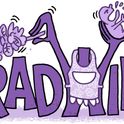Welcome to my head. Meet Ferdie the gingerbread man. He's a chain smoker. He lacks depth, as gingerbread men do, and when he draws on his cigarette there's no place for the smoke to go. It perfuses his biscuity body for a second and then seeps out in blue wisps, forming an aura. You wouldn't want to eat Ferdie. I'd been working hard all afternoon preparing a lecture on epilepsy surgery when the gingerbread man swaggered into my thoughts. He was fully formed—his name, his appearance, his nicotine addiction and his attitude (louche with a streak of menace). He must have been lurking somewhere all the while. I decided to take a break.
I'm pretty sure I can trace Ferdie's origins. Let's go back a few years. We're in a dank crevice of a drab city. I'm sitting opposite Jason in his nan's back room. He stubs out a cigarette in a saucer and lights another. Jason is bare-chested and decorated with tattoos. He hasn't washed for a while. I note that it takes an effort of concentration for him to put the cigarette to his lips with the left hand as he reaches for a matchbox with the right. He stops, focuses, and works to co-ordinate the action of striking a match. Mission accomplished, he exhales and sits in a halo of smoke. I open my case, watched in silence by Jason and the dogs. Two barrel-chested rottweilers are stationed like sentries on either side of their master. Jason's nan brings us tea and biscuits. I have no appetite. It's the smell of the dogs, of Jason and worse, of shit, wafting down whenever the old lady opens the door that leads upstairs to her bed-ridden husband. A high wall of black bricks overshadows the backyard. I have no idea what lies beyond but I'd rather be there.
The scar across Jason's head is visible through a close crop of red hair. This is where the surgeon raised the flap of bone to make a trapdoor. He dropped through into the cleft between Jason's cerebral hemispheres and worked his way down to the corpus callosum. This great bridge of fibres is the main channel of communication between the two sides of the brain. It yields easily to a surgeon's knife. Jason's left frontal lobe is now disconnected from the right. This is known as an anterior partial callosotomy. The idea was to control his epilepsy by confining the spread of abnormal neuronal activation to one side of the head. As a last resort, it can be an effective procedure in some cases when the patient is unresponsive to anti-epileptic medication and when other, less drastic, forms of surgery are unfeasible. But not for Jason. The fits are as bad as ever and I'm here to catalogue the collateral damage. I lay my equipment out on the table and ask him if he minds doing a few tests. "Do we have to?" he says. I promise I'll keep it brief. Through the window I can see sunlight catching the weeds at the top of the wall. It looks like the Garden of Eden out there.
Time drags laboriously in the blue fug. Jason is working on an object assembly task, which is a kind of jigsaw puzzle drained of colour and interest. I'm testing his visual-constructional skills. He pushes the pieces around without enthusiasm. "This is a fucking waste of time," he says. He's probably right. But then there's a spark of interest. He transfers his cigarette from right hand to left and starts sliding the pieces into place. As the right hand works on the puzzle my attention is drawn to the left. It turns oddly, jerking the cigarette this way and that. It pauses, then, with casual purpose, reaches over and jabs the cigarette into the back of the right hand. "Bastard! Bastard!" Jason is on his feet, gripping the wrist and staring intently at the fingers of his left hand as if eyeing the fangs of a venomous snake. He settles the dogs, lights another cigarette (which this time he rests on the saucer) and completes the puzzle. I ask if this happens very often, the left hand acting out of control. "Every now and then," he says. "You have to keep an eye on him." Jason's nan hands me a little packet when I leave. It contains a homemade gingerbread man. I thank her but later, somewhat guiltily, I throw it away.
I can see the connection. I was reading about callosal surgery and out pops a sprite from the backwoods of my memory. It takes the form of a folk-tale figure that perfectly embodies the essence of an unsettling experience. I can see the connection—but blimey! What else is lurking in the forest? And why "Ferdie"? Well, that's not so difficult to explain. I am mildly synaesthetic. That is, my central nervous system plays the game of cross-referencing sensory experiences. Sound carries connotations of vision, and vice versa. Words, including proper names, have different colours and textures. "Michael" for example is a metallic blue; "Claire" is pale green silk; "Daniel" is a copperish brown. I can almost taste the crumbly, gingeriness of "Ferdinand." According to one theory, word-colour synaesthesia may be due to abnormal neuronal projections. The regions of the brain that process verbal information are interlinked with those involved in colour perception. Jason was missing some connections in his vandalised brain. I, on the other hand, seem to have a few too many.











